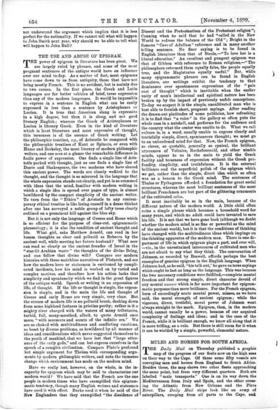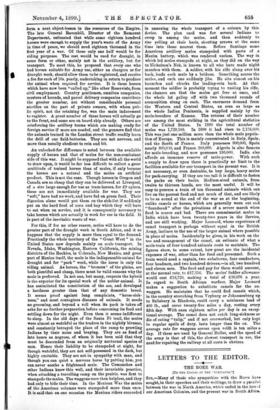MULES AND HORSES FOR SOUTH AFRICA.
THE Daily Mail on Thursday published a graphic map of the progress of our fleets now on the high seas on their way to the Cape. Of these some fifty vessels are conveying men and horses from England to South Africa. Besides these, the map shows two other fleets approaching the same point, but from very different quarters. Both are labelled " mule transports." One is on its way down the Mediterranean from Italy and Spain, and the other cross- ing the Atlantic from New Orleans and the Plate River. The Daily Hail ships look like an army of caterpillars, creeping from all parts to the Cape, and
form a neat object-lesson in the resources of the Empire. The late General Ravenhill, Director of the Remount Department, estimated that while some eighteen hundred horses were enough to supply the year's waste of the Army in time of peace, we should need eighteen thousand in the first year of a war. Of these only one half would be for riding purposes. The rest would be used for draught, in some form or other, mainly not in the artillery, but for transport. To meet this, he proposed that every one who had horses suitable for Army use, either as chargers or for draught work, should allow them to be registered, and receive a fee for each of 10s. yearly, undertaking in return to produce the animal when required for service. It is these horses which have now been "called up," like other Reservists, from civil employment. Country gentlemen, omnibus companies, masters of hounds, and parcel delivery companies contribute the greater number, not without considerable personal sacrifice on the part of private owners, with whom pub- lic spirit, not the retaining fee, was the main inducement to register. A great number of these horses will actually go to the front, and some are on board ship already. Others are reinforcing the artillery teams which are making ready for foreign service if more are needed, and the gunners find that the animals trained in the London street traffic readily learn the drill of our field-batteries. They are not nervous, and more than usually obedient to rein and bit.
An unlooked-for difference is noted between the available supply of horses and that of mules for the non-combatant side of this war. It might be supposed that with all the world to draw upon, it would be far leas difficult to collect a great multitude of trained horses than of mules, if only because the horses are a natural and the mules an artificial product. This is not the case. Though horses in Oregon and Canada are so cheap that they can be delivered at Liverpool, of a size large enough for use as tram-horses, for £9 apiece, these are not immediately available for war. They are "soft," have had no work, and have fed on green food. Their digestion alone would pat them on the sick-list if suddenly put on the hard food of corn and hay which they will have to eat when on service, and it is consequently necessary to take horses which are actually in work for use in the field. It is part of the inevitable waste of war.
For this, if for no other reason, mules will have to do the greater part of the draught work in South Africa, and it so happens that the supply is more than equal to the demand. Practically the whole territory of the " Great West " in the United States now depends mainly on mule transport. In Nevada, Idaho, Washington, Eastern California, the mining districts of the Rockies, in Colorado, New Mexico, and great part of Mexico itself, the mule is the indispensable animal for draught and for " pack " work, while the horse is only the riding animal. As horses, the " broncos" of the plains, are both plentiful and cheap, there must be valid reasons why the mule is preferred. In not one, but many, respects the hybrid is the superior for its special work of the nobler animal. It has assimilated the constitution of the ass, and developed a hardness greater than that of any domestic breed. It seems proof against lung complaints, "horse-sick- ness," and most contagious diseases of animals. It needs no grooming, and beyond a roll when its pack is taken off asks for no further preparation before consuming its food and settling down for the night. Even then it seems indifferent to sleep. In the old days of the Santa Fe trail, the males were almost as watchful as the traders in the nightly bivouac, and constantly betrayed the place of the camp to prowling Indians by their noise and braying. They are as fond of late hours as negroes, of whom it has been said that they must be descended from an originally nocturnal species of men. Hence their liability to be stampeded at night, for though watchful, they are not self-possessed in the dark, but highly excitable. They are not in sympathy with man, and though you can quiet a nervous horse by patting him, you can never soothe a frightened mule. The Comanches and other Indians knew this well, and their invariable practice, when attacking a travelling camp on the prairie, was first to stampede the mules. The waggons were then helpless, and they had only to bide their time. In the Mexican War the mules of the American columns were stampeded more than once. It is said that on one occasion the Mexican riders succeeded in annexing the whole transport of a column by this device. The plan used was for several Indians to creep in among the mules, and then suddenly to rise yelling at their heels, shooting arrows at the same time into those nearest them. Before Santiago some American artillery mules stampeded with parts of a Maxim battery, which was rendered useless. The way in which led mules stampede at night, as they did on the way to Nicholson's Nek, is known to all who have made night marches with them. A soldier, with his rifle slung over his back, leads each mule by a bridoon. Something scares the mules, and each one suddenly jibs. He sits almost on his haunches and chucks the leading-rein back. At that moment the soldier is probably trying to unsling his rifle. the chances are that the males get free at once, and the whole lot gallop off with two thousand rounds of ammunition slung on each. The enormous demand from the Western and Central States, an area as large as the whole Indian Peninsula, is supplied mainly by the mule-breeders of Kansas. The returns of their number are among the most striking in the agricultural statistics of the United States. In 1880 the total number of mules was 1,729,500. In 1896 it had risen to 2,134,000. This was just one million more than the whole mule popula- tion of Europe. This is mainly concentrated in Italy, Spain, and the South of France. Italy possesses 300,000, Spain nearly 800,030, and France 200,000. Algeria is also famous for mole-breeding, and now possesses 150,000. India also affords an immense reserve of mule-power. With such a supply to draw upon there is practically no limit to the facilities available for our transport in the present war. It is not necessary, or even desirable, to buy large, heavy mules for pack-carrying. If they are too tall it is difficult to fasten the packs on their backs. Medium-sized animals, from twelve to thirteen hands, are the most useful. It will be easy to procure a train of ten thousand animals which can live on the poorest food and not much of that, and are likely to be as sound at the end of the war as at the beginning, unlike camels or horses, which are generally worn out and " foundered " after the privations of a severe march when food is scarce and bad. There are commissariat mules in India which have been twenty-two years in the Service, and are still working. Major Leonard, whose experience of camel transport is perhaps without equal in the British Army, inclines to the use of the larger animal where possible in place of mules. Incidentally he gives, in his work on the use and management of the camel, an estimate of what a mule-train of four hundred animals costs to maintain. The figures show, to some extent, how great are the incidental expenses of war, other than for food and personnel. Such a train would need a captain, two subalterns, four conductors, four headmen, and two hundred drivers,—in all, two hundred and eleven men. The food and pay for them would amount, at the normal rate, to 217,356. The mules' fodder allowance would cost £18,720, making a total of £36,076 a year. In regard to South African warfare, Major Leonard makes a suggestion to substitute camels for the ox- waggon. He maintains that he could find camels which, in the country stretching from Vryburg or Johannesburg up to Salisbury in Rhodesia, could carry a minimum load of 400 lb., and cover twenty-five miles a day, resting every fifth day. With oxen eighteen miles per day is an excep- tional average. The camel does not catch lung-sickness or die of eating "tulip," and if not overworked, but only kept to regular spells of duty, lasts longer than the ox. The average rate for waggons across open veldt is ten miles a day. If these are used by General Buller, and the speed of the army is that of this, the slowest transport in use, the need for repairing the railway at all costs is obvious.























































 Previous page
Previous page